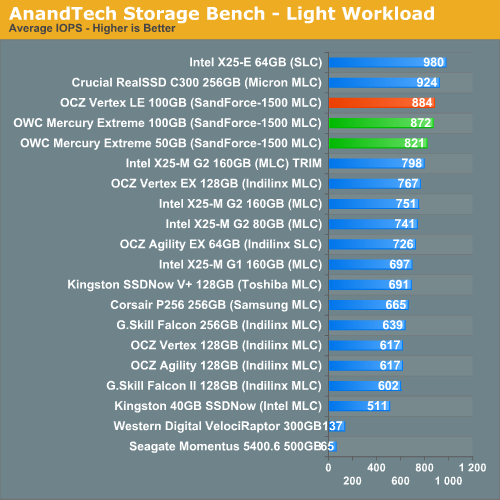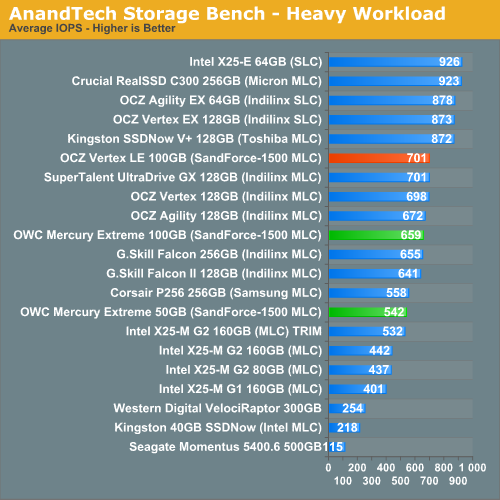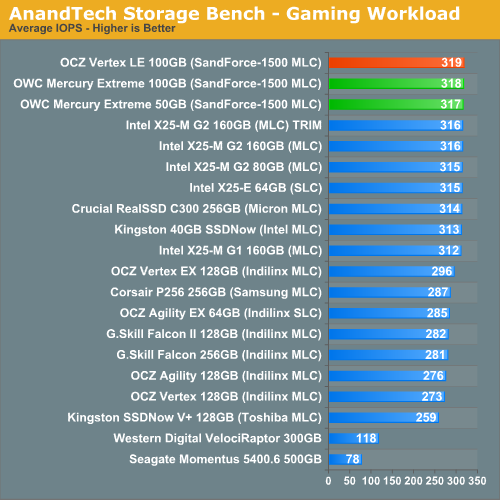OWC Mercury Extreme SSD - First Look at a 50GB SandForce Drive
by Anand Lal Shimpi on February 26, 2010 12:00 AM EST- Posted in
- Storage
AnandTech Storage Bench
Note that our 6Gbps controller driver isn't supported by our custom storage bench here, so the C300 results are only offered in 3Gbps mode.
The first in our benchmark suite is a light usage case. The Windows 7 system is loaded with Firefox, Office 2007 and Adobe Reader among other applications. With Firefox we browse web pages like Facebook, AnandTech, Digg and other sites. Outlook is also running and we use it to check emails, create and send a message with a PDF attachment. Adobe Reader is used to view some PDFs. Excel 2007 is used to create a spreadsheet, graphs and save the document. The same goes for Word 2007. We open and step through a presentation in PowerPoint 2007 received as an email attachment before saving it to the desktop. Finally we watch a bit of a Firefly episode in Windows Media Player 11.
There’s some level of multitasking going on here but it’s not unreasonable by any means. Generally the application tasks proceed linearly, with the exception of things like web browsing which may happen in between one of the other tasks.
The recording is played back on all of our drives here today. Remember that we’re isolating disk performance, all we’re doing is playing back every single disk access that happened in that ~5 minute period of usage. The light workload is composed of 37,501 reads and 20,268 writes. Over 30% of the IOs are 4KB, 11% are 16KB, 22% are 32KB and approximately 13% are 64KB in size. Less than 30% of the operations are absolutely sequential in nature. Average queue depth is 6.09 IOs.
The performance results are reported in average I/O Operations per Second (IOPS):

In our light workload we see a small performance drop from the 100GB to 50GB capacity point. It's nothing tremendous though and definitely not noticeable in real world usage. Other than the usual performance degradation issues you see with running an SSD close to max capacity, you shouldn't really see any difference in performance between a 50GB or a 100GB SandForce drive.
If there’s a light usage case there’s bound to be a heavy one. In this test we have Microsoft Security Essentials running in the background with real time virus scanning enabled. We also perform a quick scan in the middle of the test. Firefox, Outlook, Excel, Word and Powerpoint are all used the same as they were in the light test. We add Photoshop CS4 to the mix, opening a bunch of 12MP images, editing them, then saving them as highly compressed JPGs for web publishing. Windows 7’s picture viewer is used to view a bunch of pictures on the hard drive. We use 7-zip to create and extract .7z archives. Downloading is also prominently featured in our heavy test; we download large files from the Internet during portions of the benchmark, as well as use uTorrent to grab a couple of torrents. Some of the applications in use are installed during the benchmark, Windows updates are also installed. Towards the end of the test we launch World of Warcraft, play for a few minutes, then delete the folder. This test also takes into account all of the disk accesses that happen while the OS is booting.
The benchmark is 22 minutes long and it consists of 128,895 read operations and 72,411 write operations. Roughly 44% of all IOs were sequential. Approximately 30% of all accesses were 4KB in size, 12% were 16KB in size, 14% were 32KB and 20% were 64KB. Average queue depth was 3.59.

Crank up the IOPS and our 50GB drive stops doing so well. I should point out that despite its fall from grace, the 50GB OWC drive is still as fast as the 160GB Intel X25-M G2. While there's indeed a drop in random write speed, it doesn't appear to be a crippling drop.
Our final test focuses on actual gameplay in four 3D games: World of Warcraft, Batman: Arkham Asylum, FarCry 2 and Risen, in that order. The games are launched and played, altogether for a total of just under 30 minutes. The benchmark measures game load time, level load time, disk accesses from save games and normal data streaming during gameplay.
The gaming workload is made up of 75,206 read operations and only 4,592 write operations. Only 20% of the accesses are 4KB in size, nearly 40% are 64KB and 20% are 32KB. A whopping 69% of the IOs are sequential, meaning this is predominantly a sequential read benchmark. The average queue depth is 7.76 IOs.

We've already shown that read speeds are no lower with the 50GB drive, and thus our gaming workload which involves mostly texture/level loads off of the SSD shows no difference between the various capacity points of SandForce drives. We're still very bottlenecked by 3Gbps SATA here.










74 Comments
View All Comments
lorteti - Saturday, February 27, 2010 - link
Anand,How about the used drive performance?
I'm currently still unsing Vista, no plan upgrading to Win7 this year.
I think many are still using older OS.
Does these SSD's SandForce and C300 perform the same in used condition without TRIM?
jx
shawkie - Saturday, February 27, 2010 - link
Anand, can you please include some discussion and/or benchmark on power consumption for those users with laptops?shawngmc - Saturday, February 27, 2010 - link
Anand,Can you confirm whether or not this series of drives have Trim support? I had emailed OWC's tech support to try to find out, and they responded saying that their drives handle Trim internally.
I asked if I could get some details on this, but the technician did not have any. I can understand if they do automatic garbage collection, and I understand that the cycling is much lower due to the low 'write amplification' factor, but that's still not Trim support. You said that the Vertex LE supported Trim, and it's roughly the same drive, but I don't want to make an assumption I'll regret.
It's especially vexxing since OSX has no native Trim support, while I want to use this as a Windows 7 drive (as will many people after this review).
I've been waiting for SSD prices to drop, and while this isn't a drop inherently, 100GB that literally saturates SATA II for $400 is a very tempting spot to jump in.
Thanks,
Shawn
ScavengerLX - Saturday, February 27, 2010 - link
Do you dream about SSDs, Anand?Paladin1211 - Saturday, February 27, 2010 - link
Normally you dont dream about your work, right? :DScavengerLX - Saturday, February 27, 2010 - link
Yes :-Diwodo - Friday, February 26, 2010 - link
"6Gbps SATA will only improve large file read performance off of the drive. Loading apps and games shouldn't be any faster. Nearly all high performance SSDs load a single app/game in about the same time. "So you are saying we are already reaching tipping point where SATA3 with 700MB/s Seq Read / Write wont give us any perceivable performance advantage? I did do any research or test, but surely Apps like Photoshop / Office / Games require to load more then few hundred MB right?
Paladin1211 - Saturday, February 27, 2010 - link
I think the statement is pretty logical. Assume that you have 350MB/s sequential read and I have only 200MB/s. We both need to read a file of 20MB. Then it would take you 0.057 sec or take me 0.1 sec. Even a mouse click would take longer than the 0.043 sec difference :)To load apps and games means to process a lot of small files, not one large file of multi hundred MB. This is where random read/write comes into play, negating most of the sequential advantages.
Conscript - Friday, February 26, 2010 - link
thanks for the review Anand, I've been looking up and down at these drives and was waiting for a reliable review. I am concerned that they won't let you open em up. Tell ya what, why don't you give them the $229, check to make sure there's nothing funny going on, and when you put it back together and check that it still works, I'll buy it off ya...and a used discount of course :)ssdreviewer - Friday, February 26, 2010 - link
we would like to see more latency benchmark info in all SSD reviews, such as AS SSD benchmark, HDTune Pro access time etc.